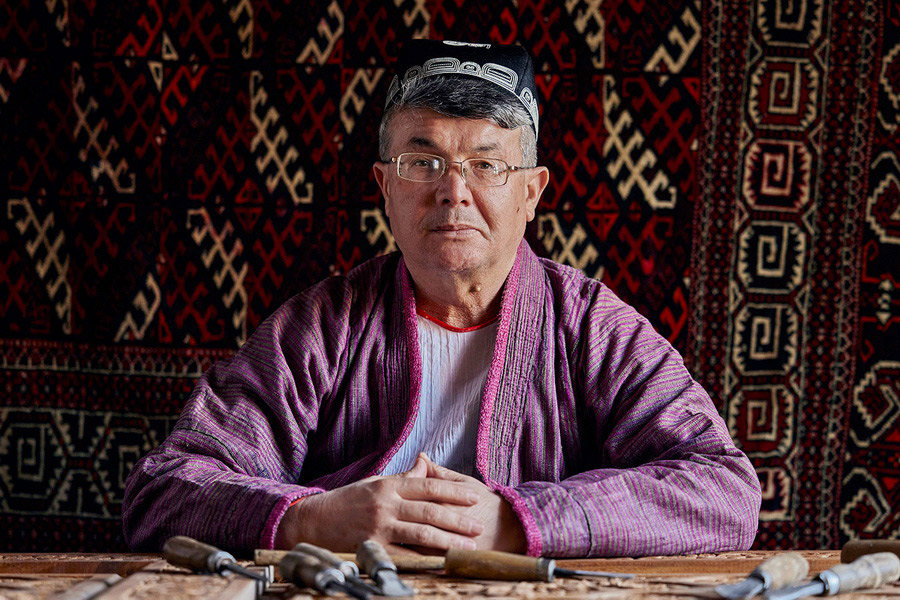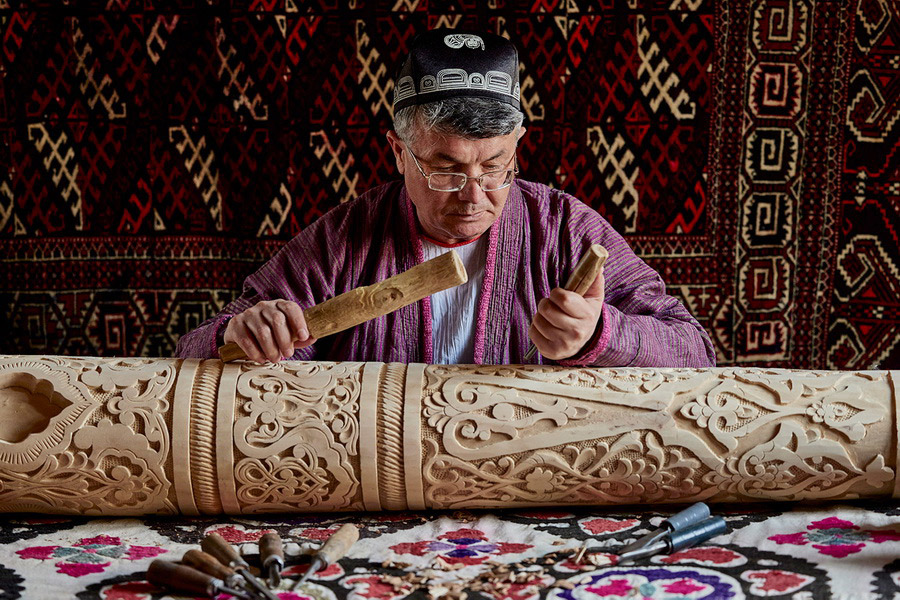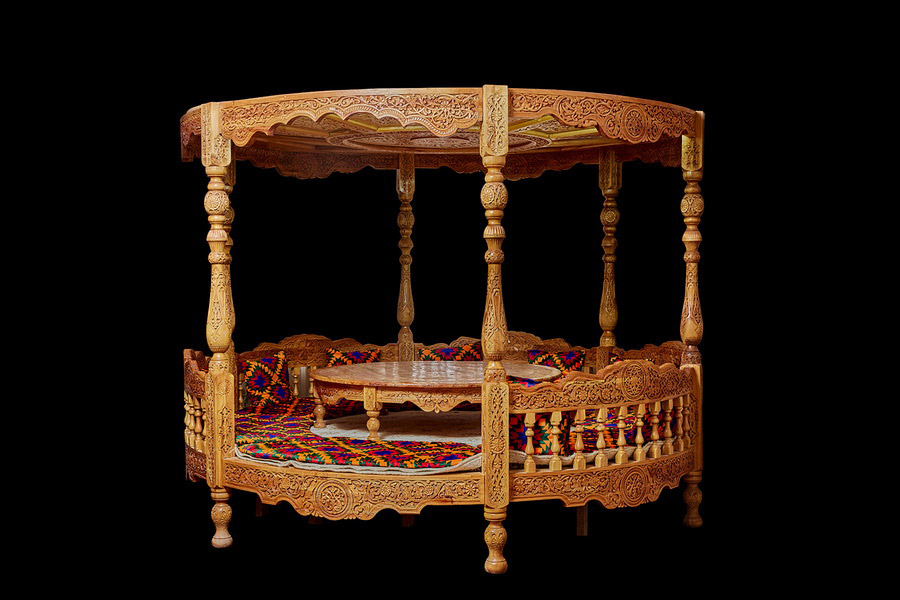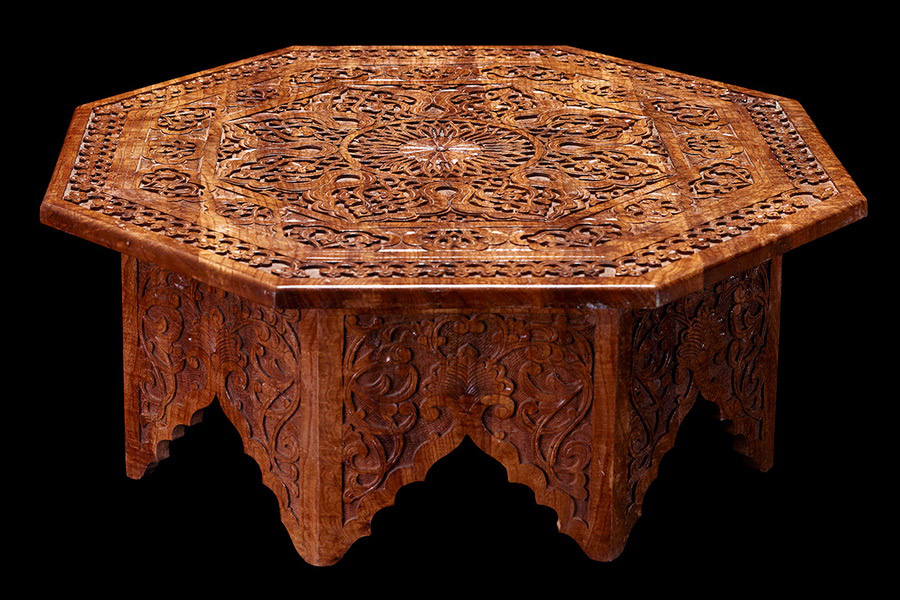
Photos Source: www.2022.homofaber.com
Odamboy Masharipov is a master woodcarver, one of the best craftsmen in Uzbekistan and a recipient of the Presidential Award. In 2022, he was included in the Homo Faber Guide – a prestigious listing of internationally renowned artisans.
The Path to Mastery
Odamboy Masharipov was born and raised in Khiva. He began learning the craft of woodcarving at the age of 12. Initially introduced to the art by his father, he became an apprentice in 1989 to the renowned Khiva master Khayitmat Bogibekov. It took him more than 12 years to master all the nuances of the craft. After that, he began working independently, developed his own style, and in 2002 opened his own workshop. The craftsman has devoted his entire life and career to the deep study and advancement of the art of woodcarving.
Woodcarving is a distinctive Uzbek craft that flourished from the late 19th to early 20th centuries. In the 19th century, carved architectural elements – such as columns and doors – as well as decorative household items, were commonly used to adorn the homes of noble families, khans, and religious buildings. Among the various regional schools of woodcarving in Uzbekistan, the Khiva school – represented by Odamboy Masharipov – is considered one of the most refined and expressive.
The Art of Woodcarving in Khiva

The renowned 19th–20th century craftsman Ata Palvanov (1867–1972) is considered the founder and leading figure of the Khiva school of woodcarving. For many years, he worked alongside his student and colleague Safo Bogibekov (1903–1978). Today, their traditions are carried on by Safo Bogibekov’s son, Khayitmat Bogibekov (born in 1953), and his students.
The key ornamental motifs of the Khiva school include islimi, pargori, and baghadi. Islimi – a floral design featuring curling vines and shoots – is the most widely used and also appears in other regional forms of this Uzbek craft. Pargori and baghadi are simpler, geometric patterns that typically complement the primary plant-based ornamentation. When decorating an object, Khiva craftsmen carve the designs at varying depths, adding dimensionality and a unique visual rhythm.
A striking example of the Khiva style can be seen in the carved columns of the Juma Mosque in Khiva. These more than 200 monumental works from the 18th–19th centuries feature dense, intricate designs and stand as a testament to the heritage and sophistication of woodcarving as part of Uzbekistan’s rich handicraft tradition.
Works by Odamboy Masharipov

The master craftsman creates distinctive interior and household items, including tables, chairs, and unique wooden miniature replicas of historic buildings in Uzbekistan. His portfolio also includes large-scale pieces such as intricately carved gates and columns. He works exclusively with high-quality wood, and his style is marked by refined ornamentation and exceptional attention to detail.
While he largely adheres to the centuries-old traditions of Khiva wood carving, the master is unafraid to experiment. His most notable innovations in this traditional Uzbek craft involve ornament design and the use of mixed materials. In some of his works, he skillfully combines wood with ceramics – a creative approach for which Odamboy Masharipov was awarded the Prize of the President of the Republic of Uzbekistan.
Workshop

Odamboy Masharipov opened his workshop in 2002 in the heart of historic Khiva, within the Ichan-Kala fortress. Over more than two decades, he has created a space dedicated to both artistic work and teaching, along with a small personal museum.
The master trains students, passing on the secrets of ancient Uzbek craftsmanship, and regularly offers guided tours for visitors.
His works can be viewed by appointment only. He speaks Uzbek.
Visitor Information
- Address: Gandyman Village, Yuzboshi 111, 220900, Khiva, Uzbekistan
- Phone: +99898 5779192, +99891 9960900
- Opening hours: by appointment

